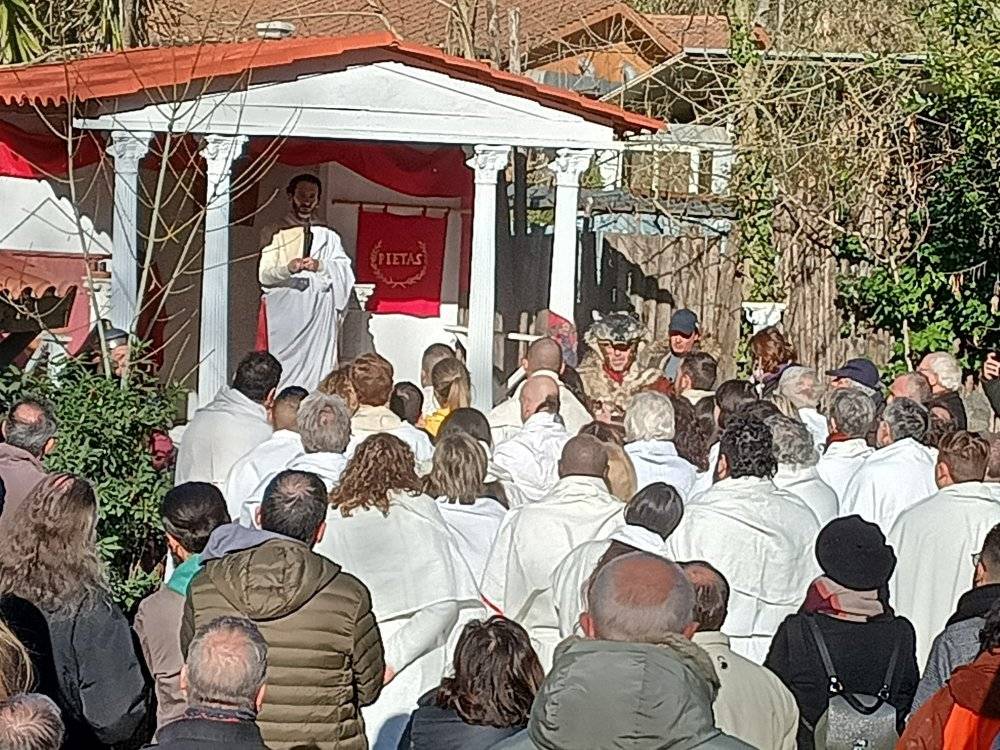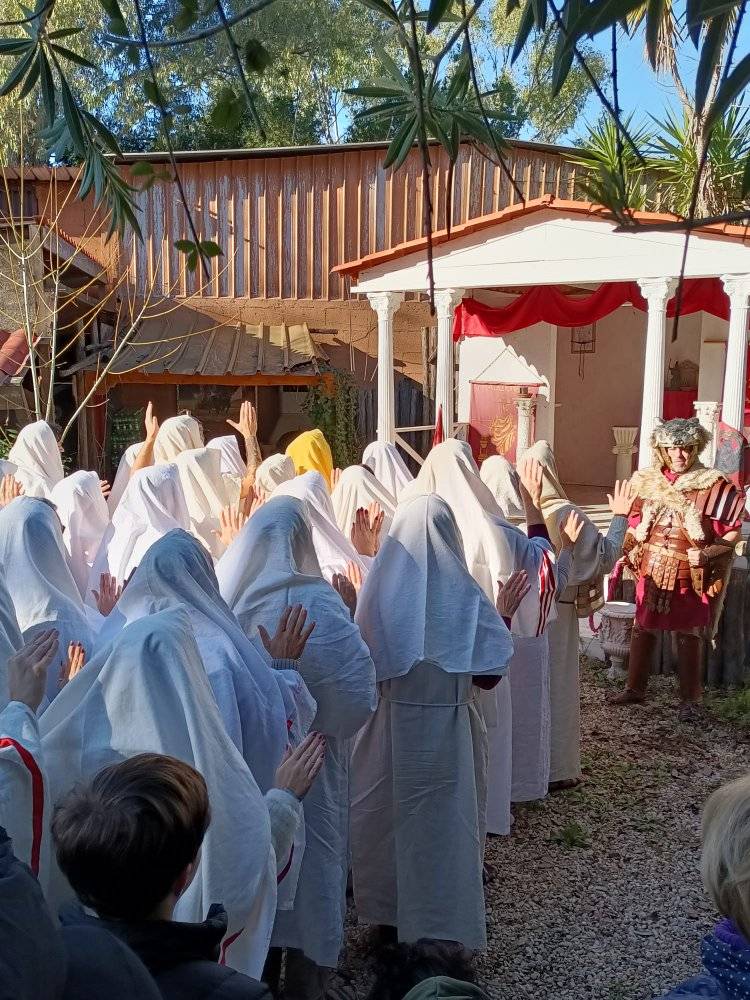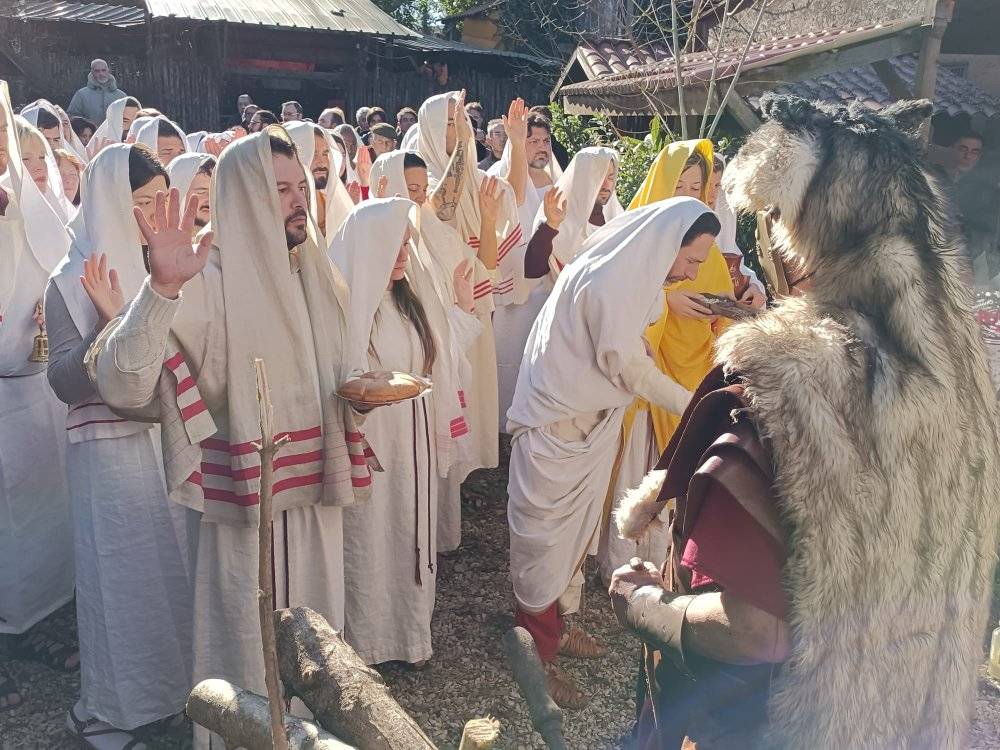TWH – Saturnalia was an ancient and revived Roman festival that takes place in December from the 17th to the 23rd. The festival celebrates the agricultural god Saturn.
In ancient Rome, the festival was characterized by feasting, gift-giving, and a temporary suspension of social norms and hierarchies. It was a time of revelry, merriment, and indulgence, with activities such as feasting, gambling, and the exchange of small gifts.
Today, members of various polytheist faiths and others in the Pagan community continue the celebration of Saturnalia. But other communities are also celebrating Saturnalia as well.

Winter or the Saturnalia (1783) by Antoine-Francois Callet.
Saturnalia typically occurred around the time of the winter solstice, which in the Roman calendar fell in late December. The festival was a time for people to come together, regardless of social class, and participate in festivities that provided a temporary break from the usual societal norms. During Saturnalia, schools and businesses closed, and public life was marked by a sense of freedom and celebration.
Homes were adorned with wreaths and various greenery during Saturnalia, and the customary togas were set aside in favor of vibrant attire known as “synthesis.” Even those who were enslaved were granted respite from their usual duties, being encouraged to join in the celebrations. In certain instances, they were even seated at the head of the table while their masters served them.
Rather than engaging in regular work, the Romans dedicated their time during Saturnalia to activities like gambling, singing, musical performances, indulgent feasting, socializing, and the exchange of gifts.
One of the notable features of Saturnalia was the role reversal, where slaves and masters temporarily switched roles. This inversion of social hierarchies was a symbolic gesture of equality and freedom during the festival. Within Roman households, a figure known as the Saturnalicius princeps, or the “leader of Saturnalia,” often referred to as the “Lord of Misrule,” was selected. Typically chosen from among the lower social ranks of the household, this individual had the amusing responsibility of causing mischief during the festivities including insulting guests, donning eccentric attire, and engaging in flirtations.

The debauchery was noteworthy. Anthropologist and bioarchaeologist, Susan Lanigan said in an interview with LGBTQNation, “Saturnalia was all about emulating the social freedom integral to Greek culture. Hence, drag was openly encouraged. We have more than one record from the period describing boys running naked through the streets, men dressed as women, women dressed as men, masters of the house waiting on slaves, and an overabundance of wine, cunnilingus, and fruitcake. In that order.”
![]()
We know it’s tiring to see this over and over and we hate to keep asking.
We are grateful to our readers for your support however it manifests. Right now, we need readers who can help fund Pagan journalism to help us continue serving the community. This is the type of story you only see here. This is how to help:
Tax Deductible Donation | PayPal Donations | Join our Patreon
We remain one of the most widely-read news magazines within modern Paganism- together as reporters and columnists dedicated to a vision of journalism for and about our family of faiths.
You can also help us by sharing this message on your social media.
As always, thank you for your support of The Wild Hunt!
![]()
The custom of gift-giving during Saturnalia has some parallels with modern Christmas traditions. A prevalent gift during this festival was the wax taper candle, or “cerei,” symbolizing the return of light following the solstice.
Over time, the celebration of Saturnalia influenced certain aspects of later winter festivals, including some customs associated with Christmas. While Saturnalia itself is no longer celebrated, its cultural and historical significance can still be observed in the way some modern societies celebrate the holiday season.
Last week, the cathedral city of Chester in northwest England, bordering on Wales and quite proud of its Roman heritage, was “filled with the same sights, sounds and smells that have marked Saturnalia in the city since its days as the Roman city of Deva Victrix,” likely after the goddess of the River Dee. The city was founded by Emperor Vespasian in 79 CE. The city center boasts a Roman amphitheater.
“Chester is a Roman city and Saturnalia offers the opportunity to combine the modern-day Christmas celebrations with an acknowledgement to our Roman history,” said Chester West and Chester councillor Lisa Denson. “Roman soldiers marching through the city centre always attracts the crowds, [who enjoy it when] the soldiers light their flaming torches and share the light by handing out glow sticks.”
Closer to Rome, Associazione Tradizionale Pietas honored Saturn and celebrated Saturnalia in the Eternal City. Pietas – Comunità Gentile is a reconstruction of the ancient priestly and religious rites of Religio Romana and recently received formal recognition from the Italian state.
Pietas is based in Rome and has affiliates in cities throughout Italy, including Bologna, Genoa, Milan, Palermo, and now Taranto, itself an ancient Spartan colony. The region is often referred to as Magna Graecia, which includes the present-day Italian regions of Apulia, Basilicata, Calabria, Campania, and Sicily. The organization has also arduously and carefully reconstructed elements of Religio Romana using ancient sources that are both Pagan and Christian to gather as much historically reliable material to develop its rites. Pietas is now recognized under Italian law as a valid national religious community. The group has been actively reviving and building new temples throughout Italy.
Pietas shared these images of their celebration led by Pontifex Maximus Hermes Helios. Helios said in a broadcast discussion last week that the festival of Saturnalia “reminds us that all persons are equal… even in a complex societal structure like that of Rome, we all have the same origin.” He added that for a few days, everyone would return to a “golden age.”
With a note that read “Today the ties that bind the God Saturn have been untied. Io Saturnalia,” Pietas shared images of their celebration:
The theme of liberation permeates the holiday. Romans would place woolen ties to symbolically bind statues of Saturn. John Miller, Arthur Stocker Professor of Classics at the University of Virginia, said, “Removing the symbolic bonds on the statue was a release.”
In the Saturnalia, Lucian writes and says that Sturn himself declares, “During My week the serious is barred; no business allowed. Drinking, noise and games and dice, appointing of kings and feasting of slaves, singing naked, clapping of frenzied hands, an occasional ducking of corked faces in icy water—such are the functions over which I preside.”
Io Saturnalia!
The Wild Hunt is not responsible for links to external content.
To join a conversation on this post:
Visit our The Wild Hunt subreddit! Point your favorite browser to https://www.reddit.com/r/The_Wild_Hunt_News/, then click “JOIN”. Make sure to click the bell, too, to be notified of new articles posted to our subreddit.


